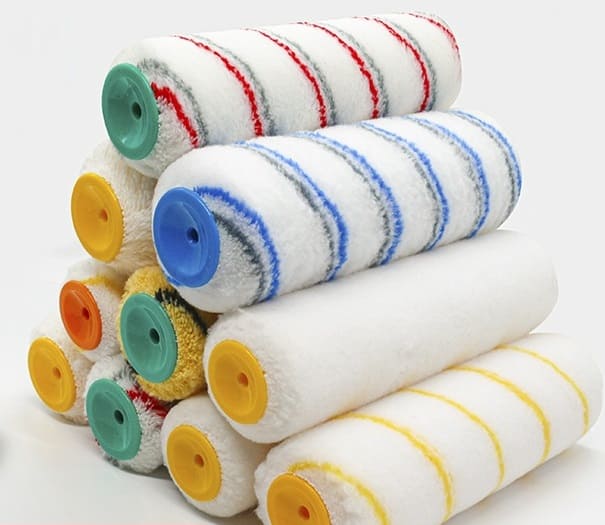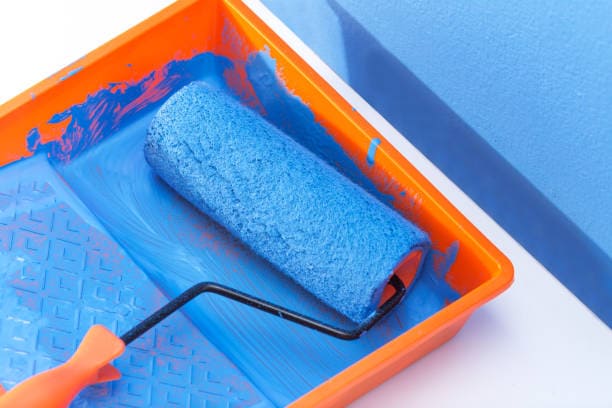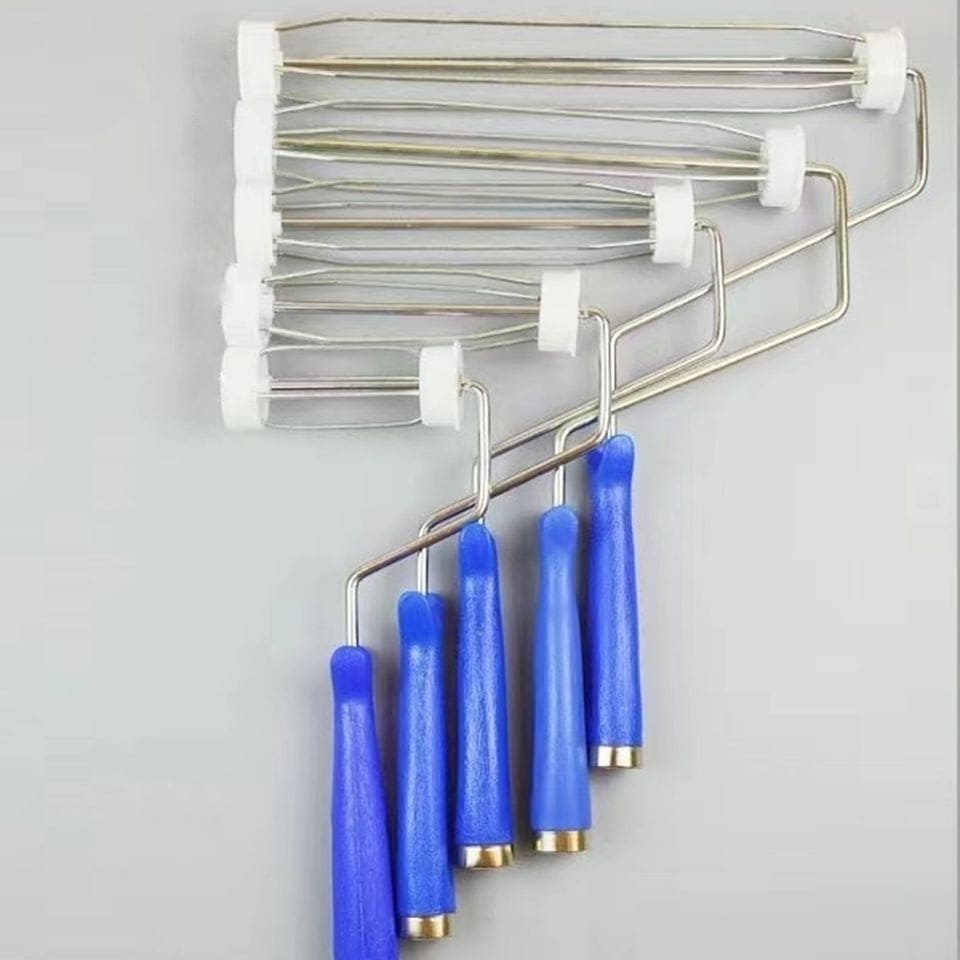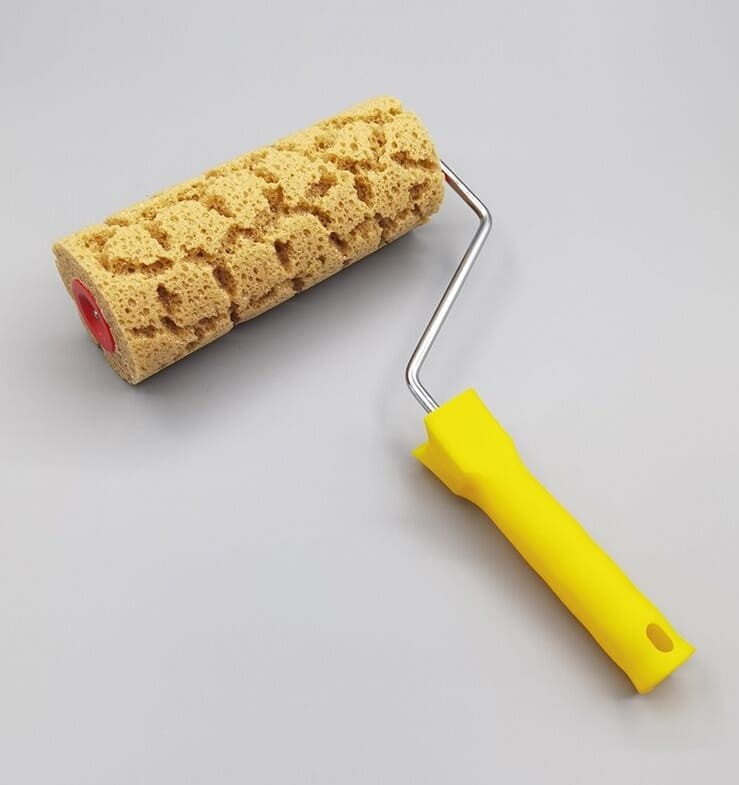Painting a room is a typical DIY project that many people undertake. They pick up paint, a paint tray, a paintbrush, and a paint roller and then start painting the walls. However, if you haven’t tackled a paint project before, you may not know that paint, paint trays, paintbrushes, and paint rollers come in several different types. Choosing the wrong paint tray can slow the project while selecting the wrong brush can leave you with a streaky finish. For these reasons, along with several others, learning more about the paint and tools you need before starting a project is essential.

Buying Considerations for Paint Rollers
When you’re ready to paint your home, it’s tempting to grab the first roller you see and ignore the size of the roller, where it will be used, or what type of roller cover is needed. But this mistake can delay your project and result in an uneven finish.
It’s essential to take some time to learn about what to consider when buying a paint roller. In this article, we’ll discuss paint roller size, Different Materials of paint rollers And Their Uses and how to choose the right roller for your needs. As well we will give some tips on how to use it properly.
Size
When you’re painting, there are a lot of choices to make—from the colour to the brand of paint and even how big your roller should be. Also, there are different sizes of rollers.

Paint rollers come in several sizes, so you must consider the area you will be working in before deciding on a paint roller. If you are painting average-sized walls, it’s best to look for a standard roller, which typically measures 9 inches. For more enormous walls and ceilings, you can find oversized paint rollers ranging in size from 12 inches to 18 inches.
However, a mini paint roller is the right way to go if you are working with trim, doors, paint roller frames, or narrow walls. They come in various lengths, including 2-inch, 3-inch, 4-inch, and 6-inch. Remember that a project may need more than one roller size.
Different Materials of paint roller And Their Uses
Paint Roller Covers
Paint roller covers are the central part of a paint roller. It’s typically made of woven or knit synthetic material, lambswool, or foam. Or microfiber.

Woven synthetic roller covers are suitable for interior walls and ceilings because they don’t shed as much as lambswool and create a smooth, even finish. These covers work well with glossy finishes but aren’t recommended for flat or eggshell finishes.
The High-Density Polyester Roller Covers are designed for all-smooth to semi-smooth surfaces. The rollers are reusable and can be used with paints and stains.
Knit synthetic sleeves are best for flat or eggshell finishes. These sleeves work well with glossy latex paint but aren’t recommended for oil-based paints.
Polyamide: This short pile paint roller is made of a continuous curly filament. This material produces a smooth, even layer of paint that adheres to the surface. It’s the perfect paint roller for industrial and shipbuilding applications, and it has the added benefit of creating a plaster-like texture on uneven walls by warping during application.
Lambswool roller covers are great for oil-based paints because they absorb more than other fabric types. Hence, it creates an even finish that doesn’t require the reapplication of paint between coats or multiple passes over surfaces with the identical roller (which can cause streaking). Lambswool is also suitable for glossy latex.
The acrylic roller is a versatile and reliable choice for emulsion and masonry paints. This woven acrylic roller gives excellent performance at a reasonable cost and is suitable for use with a wide range of paint types. The short pile makes it ideal for a smooth or semi-smooth surface.
Microfiber rollers can help you avoid streaks and give you a smooth, even coat of paint. Because the material can absorb paint evenly, resulting in a streak-free finish.
Foam rollers are great for painting smooth surfaces—like fine furniture or woodwork—because they leave a smooth, even coat of paint that doesn’t run or drip. Use these rollers with varnish, polyurethane, or paint to finish off woodworking projects and make them look like they came straight from the factory.

Paint roller sleeves absorb paint from the paint tray and release it on a surface when the user applies a small amount of pressure. With this in mind, you need to carefully choose the pile height or nap of a paint roller to avoid creating an uneven finish on smooth surfaces or having difficulties painting semi-rough surfaces or heavily textured surfaces.
Standard interior paint projects typically require a paint roller sleeve with a 3/8-inch to 1/2-inch nap or pile height. However, for rougher surfaces, like the back deck or fence, a 3/4-inch to 1-inch pile height is suitable. Brick, cinder block, and stone may require a thicker paint roller pile ranging from about 1 1/4 inches to 1 1/2 inches.
Paint Roller Frame

The paint roller frame is another part of a paint roller which come in two primary varieties: those with a threaded end, which allows you to screw on and off the roller cover, and those that slip on and off. Most experts recommend using a threaded cage, as it provides a more secure fit and is less likely to come loose while you’re painting.
Types of Paint Rollers
If you’ve ever wondered what the difference is between a roller and a paintbrush or how to choose the right roller for your next painting project, you’re not alone!
It’s essential to understand the differences between different types of rollers so that you can choose the right one for your needs. When it comes to painting, there are five main types of rollers: manual, pad, textured, speciality, and mini paint rollers. Each one is designed for a specific purpose, and understanding these differences will help you effectively learn how to choose a paint roller for your next project.
Manual Paint Rollers
If you’re looking for a tool to help you paint your home, there are many different options you can choose from. Whether you’re doing it yourself or hiring someone else, knowing what kind of paint roller will work best for the job is essential.
There are two main types of paint rollers: manual and electric. Both have pros and cons, but the most common type of roller is a manual paint roller. These are the standard paint rollers with a simple handle, roller frame, and rotating metal roller typically used to paint interior walls and ceilings. They can also be used outdoors to paint exterior surfaces when equipped with the right paint roller cover.
The drawback of these paint rollers is that they can be too long for painting thin surfaces, like baseboards and door paint roller frames. However, manual rollers are one of the most affordable types available.
Pad Paint Rollers
While they are still considered rollers, pad rollers do not roll. They have a flat pad that absorbs and releases the paint onto the target surface in straight, even strokes. These rollers’ design helps prevent paint splatters familiar with manual paint rollers. However, paint pads only apply a thin layer of paint to the wall, ceiling, or any other semi-smooth surface, so they aren’t perfect for covering darker or more vibrant colours. In addition, they don’t work well on rough surfaces like brick or stucco because they can’t get into the nooks and crannies of these materials.
When using a padded roller with latex paint, it’s essential to ensure that there isn’t any oil-based residue left over from previous projects on your walls or ceilings. This could cause problems when you’re trying to apply new latex paint layers over top of old ones because oil-based paints won’t stick well with latex-based coats underneath them!
Textured Paint Rollers
A textured paint roller refers to the roller sleeve instead of the solid roller. You can use a manual roller with a textured paint sleeve to create innovative patterns or mimic designs like wood grain, brick, or stone textures. The sleeves are made with foam and have individual patterns etched in to create the desired look, though these patterns can be difficult to appreciate on small wall surfaces, so it’s best to use textured paint rollers on more enormous walls where the pattern is easy to see.

Some textured rollers have pre-etched patterns that look like wood grain, brick, or stone. These rollers are designed for applying paint quickly and easily without waiting for it to dry before going over it again with another coat of paint (which can cause uneven coverage). If you’re looking for something more sophisticated than just a basic swirl design on your wall—and you want it fast—then a textured roller might be right up your alley!
Speciality Paint Rollers
If you’ve ever used a roller to paint your walls, you know that they can be a bit of a hassle. They tend to leave paint lines in the corners and don’t always cover the wall evenly. If you want to make sure that your wall is painted perfectly and evenly, you may want to consider using a speciality paint roller instead.
A speciality paint roller is similar to a textured paint roller in that it has a unique pattern—usually in the form of ridges or bumps—that allows it to leave behind an interesting texture on your wall. However, unlike textured rollers, which are manual rollers with sleeves made out of textured material, speciality rollers are designed by the manufacturer for specific purposes: for example, for applying certain types of paint or for creating specific patterns.
You can use these rollers with any paint; however, if you’re looking for better results than what you get from a general-use textured roller sleeve, using one explicitly designed for applying certain paints may be worth considering.
Mini Paint Rollers
The mini-paint roller is the way to go when a manual roller is too big to use for thin surfaces or to get into tight corners. They come in various sizes, including 2-inch, 3-inch, 4-inch, and 6-inch, allowing you to select the correct length based on the project’s needs. Some types of mini rollers are used with small-diameter mini roller sleeves. They are referred to as mini hot dog rollers because, with the small diameter and short pile height, the roller sleeves resemble a mini hot dog. The thin roller sleeve is ideal for painting in tight corners and difficult-to-reach places, like behind the toilet.
Choose the Right Roller Cover Material Based on Your Paint and Project
- Wool or mohair roller covers
- Synthetic roller covers
- Roller covers that blend wool and polyester
- microfiber roller covers
- Foam roller covers
Know What Nap You Need for Your Surface
When ready for a fantastic paint job, you’ll need to know what type of nap to choose. The nap of a brush is the length of the fabric, which is essential because it determines how smooth or rough your final application will be.

There are four main types of paint roller covers:
- ½-inch nap: good for lightly textured surfaces, including most interior walls
- ¾-inch nap: best for heavily textured surfaces such as bare brick or concrete or textured interior walls like popcorn-textured ceilings
- ⅜-inch nap: good for lightly textured surfaces, including most interior walls
- ¼-inch nap: best for very smooth walls, ceilings, cabinetry, and other surfaces without texture
Tips on How to Use Paint Rollers Properly
– First, you must ensure that the surface you’re going to paint is even. Any bumps or unevenness will show through once you start painting.
– Second, pour your paint into a tray and roll the roller until it’s completely covered.
– Third, start painting from the top and work your way down. Overlap each stroke slightly so that you don’t miss any spots.
– Fourth, clean the roller with water and soap once you’re done painting, so it doesn’t get ruined.
These tips will help you use the paint roller properly and get the best results. Remember to take your time and be careful, and you’ll be able to achieve an excellent painting job.
Paintbrusha manufactures a wide range of paint rollers, foam rollers, microfiber rollers, mini rollers, roller covers, paint roller frames and roller trays. You can get the best products at Paintbrusha. Start Your Painting Project With Paintbrusha!
